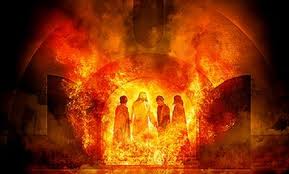The Three Hebrew Children
Central Thought: Unwavering faith in GOD brings the desired results.
Text: Daniel 3:1-30
Shadrach, Meshach and Abednego were companions with Daniel. The three young Jewish men were deported to Babylon along with Daniel. In Babylon’s religious culture, statues were commonly erected and worshipped. Nebuchadnezzar, perhaps in an attempt to unite the nation and solidify his power by centralizing worship, made a gold statue ninety feet tall and nine feet wide. He called his officials together and commanded that at the sound of the horn, flute, harp and other musical instruments, people of all races, nations and languages should bow to the golden image. This was a great challenge to the faith of Shadrach, Meshach and Abednego. A great conflict: to obey man or God. In this study we shall see what their choice was, what they passed through, the king’s decrees and repentance, the secret of their success and their reward.
-
What were the circumstances that brought the three Hebrew children to the Babylonian court? Daniel 1:1-6
King Nebuchadnezzar of Babylon invaded Jerusalem in the third year of the reign of king Jehoiakim of Judah. God gave him victory over Jerusalem. To demonstrate his dominance and victory he took the finest and wisest men and women to Babylon as captives. They were taken as trophies. Among them were Daniel, Shadrach, Meshach and Abednego. While in Babylon, the king directed Ashpzaz, his Chief of Staff to select among the young men of Judah’s royal family and other noble families, those that were strong, healthy and good looking young men. Such persons must be skillful in all wisdom, and cunning, or well-seen in knowledge and understanding of science, quick, sharp and intelligent. These people are to work in the king’s court. Such persons are to be well fed from the king’s portion to enhance their look and performance. Among those chosen for this great and privilege training and assignment were Shadrach, Meshach and Abednego. The three plus Daniel were chosen to be trained in order to serve in the king’s palace. Thus they find themselves from Jerusalem to the king’s court.
-
How can you describe the three Hebrew children from Daniel 2:17-18, and what does this teach you about Christian relationships?
When Daniel was at a crisis point, he ran to these trusted Jewish friends and they prayed together. God answered them and victory became their portion. We can learn from them that Christian friends are helpful. When we find ourselves in tight spots, we can share our needs and what we are passing through with trusted Christian friends.
Shadrach, Meshach and Abednego were three great and trusted friends. Their unity and togetherness help us think of the real meaning of friendship. Together they silently defied king Nebuchadnezzar’s order to fall down and worship his golden image. This was to attract the death penalty which could have put an end to their sweet relationship. When the king confronted them face to face and gave them another opportunity to fall down and worship the golden image, they courageously and unanimously replied “O Nebuchadnezzar, we are not careful to answer thee in this matter. If it is so, our god whom we serve is able to deliver us from the burning fiery furnace, and He will deliver us out of thine hand O king. But if not, be it known unto thee, O king that we will not serve they gods, nor worship the golden image, which thou hast set up”, Daniel 3:16-18.
It is important and rewarding to stand with others with whom we share convictions. Never abandon your friends in their times of need.
-
Read Daniel 3:1-12, and explain the issues involved.
King Nebuchadnezzar erected a golden stature ninety feet tall and nine feet wide. There are different schools of thought on why he set up the golden image. Some suggest that he did that to reassure his people that he is still with them in the worship of their many idols. This is because; of late he had spoken with great honor of the God of Israel and elevated the people to God, Daniel 2:46-49, and some of his people were not comfortable with that. Others suggested, that it was his own image, as it was the custom of the Chaldean kings to build statues of themselves and he wanted people to worship him to demonstrate his dominance and power, presenting himself as an extra-ordinary human being; that it was his pride and vanity that induced him to make this golden image for worship. Messengers were dispatched to all parts of the kingdom summoning all the governors, advisers, judges, magistrates, military commanders and all that matter to come to the dedication of this king’s golden image. Instruction was given that at the sound of the horn, flute, harp, pipes and other musical instruments, everyone must bow and worship the golden image. It was so, but Shadrach, Meshach and Abednego refused to bow.
-
Why did the three Hebrew children refuse to bow down to the golden image and give examples of things that people bow down to today? Exodus 20:3-5
On hearing the king’s command, the three Hebrew children made up their minds not to worship another god. They had been raised to the position of honor in the empire and here comes the testing time. Would they disobey God’s commandments and save their position? They were fully aware of God’s demands in Exodus 20;3-5, that they must not bow down or worship idols or any image of anything in the heavens or on the earth or in the sea. They took their stand and made it known to the king even when they knew the implication, which was the death penalty. They were ready to obey God even if he chose not to deliver them. They left for us an excellent example. Our loyalty to God is put to the test everyday as we make decisions. Today people bow and worship the god of money, fashion, material things, position, power and other mundane things. We have heard and seen people joining cults because they want to occupy political positions. Some in attempt to make money joined secret cults to perform human sacrifices. Some give their bodies to lecturers in order to pass examinations, others forged documents to achieve some objectives. These and many more are forms of bowing down to images in order to survive.
-
What was the king’s reaction to the news he heard about the three Hebrew children and why did they still refuse to bow even after the king gave them another chance? Daniel 3:13-16
When the action of Shadrach, Meshach, and Abednego was reported to the king, he flew into a rage and ordered the three Hebrew children to be brought before him. He gave them another chance and with a warning that if they fail to bow and worship the image, they will immediately be thrown into a blazing furnace. The king gave them the benefit of the doubt. He wanted to know whether it was deliberately done or was it only through inadvertency (mistake or oversight). People that he nourished, educated, brought up, maintained at his own charge. Whatever be the case he gave them opportunity to rethink and do what he considered needful.
In spite of the king’s kind gesture, they gave the king the answer they had agreed on. They resolved not to bow or worship the golden image. Their mind was made up and there was no going back. They kept their calm and did not call the king a tyrant or an idolater or such an abusive name. They had the confidence that God was able to deliver them from the fiery furnace and from the hand of the king. They also understood that God is sovereign, if He chose not to deliver them, they will not worship the golden image.
-
Compare Daniel 3:22 and 3:27 and explain their miraculous deliverance. What was the king’s reaction? Daniel 3:28-29
The king was very furious about the resolve of these young men. He then ordered that they should heat the furnace seven more times than it ought to be. The seven times more fuel was to dispatch them sooner to death. They wer bound so that they might not struggle or make any resistance. The furnace was exceedingly hot that the flame of fire slew those mighty men that the king asked to bind and cast the Hebrew children into the burning fiery furnace. Yet when the king ordered them to come out of the fire, it was discovered that the hair on their head did not singe, their clothes did not change color nor smell of fire or smoke. A fourth person was seen in the fire, some say it was the Son of God Himself. This was a mighty miracle. The fire did not have power over them. The Chaldeans worship fire as a sort of image of the sun, so that by restraining the fire form hurting His faithful servants, God put contempt not only upon their king but upon their god. The miracle was overwhelming, undeniable and unprecedented. The king acknowledged and blessed the God of Israel; He issued a royal edict strictly forbidding any to speak evil of the God of Israel. He then promoted Shadrach, Meshach and Abednego in the province of Babylon.
Daily Living Application:
Shadrach, Meshach and Abednego proved to the Chaldeans that they were different in conduct by refusing to bow down to the king’s golden image. They remained true to God even at the possible cost of their lives. They were not moved by the action of the majority. In spiritual matters, majority may not always be right. Twelve spies were sent to Canaan. Ten brought evil reports and were wrong. Two demonstrated faith in God and received divine approval. Shadrach, Meshach and Abednego believed that God would deliver them from the hand of the king and He did not disappoint them. Our God is our present help in time of need. He will never leave us nor forsake us. The Scripture teaches us to obey, honor, respect and pray for our leaders, Romans 13:1-7; 1 Timothy 2:1-2; 1 Peter 2:13-17, but our first obligation is to God Himself. Where there is a conflict between God’s commandment and man’s commandment, we have to obey God. Never bow down to any image nor obey man instead of God.
Memory Verse:
Acts 5:29 – “Then Peter and the other apostles answered and said, we ought to obey God rather than men.”

